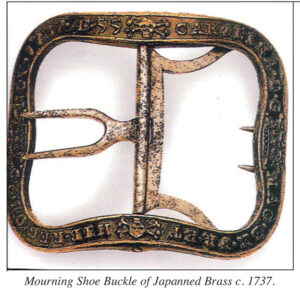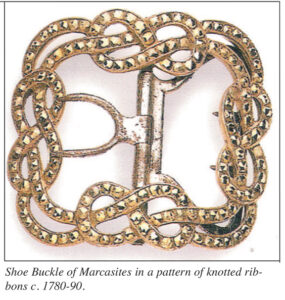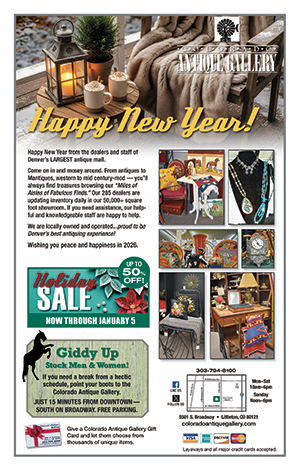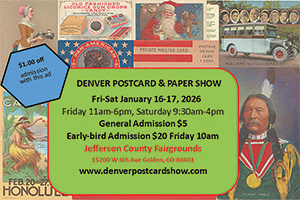 By Maureen Timm
By Maureen Timm Buckles have been used by both men and women since ancient times. History and archeology books tell of buckles used to fit harnesses on animals and to hold weapons and garments in place. The popularity of buckles as adornments fluctuated according to fashion and politics. Archaeologists have discovered primitive belts with buckles dating back to the Bronze Age, c. 3500 to 1000 BC, and in the Middle Ages 476 AD to c.1450 AD buckles were commonly used for capes, shoes and armor. These buckles were massive in size and studded with colored glass or jewels, or embossed with ornamental bronze.
During the 3rd and 2nd century BC, the Chinese semi-nomadic people known as the Xiongnu, wore belt buckles over long tunics. These buckles were highly decorated and were worn as a mark of status. Only the rich and/or powerful could afford the materials needed to make the finest buckle. Of course if you defeated your enemy in battle, the victor got the spoils!
In the 17th century shoe and garter buckles became popular in Europe and America. In the late 17th century, in Birmingham, England, the craft of buckle making started and was firmly established by the beginning of the 18th century. In the early 1700s, knee buckles became fashionable for men’s knee breeches and smaller buckles started appearing as purely decorative fashion accessories.
 Up until the start of the Industrial Revolution in 1760, only the elite were able to enjoy fine jewelry and fashion accessories. The Industrial Revolution made buckles more accessible to the common people.
Up until the start of the Industrial Revolution in 1760, only the elite were able to enjoy fine jewelry and fashion accessories. The Industrial Revolution made buckles more accessible to the common people. On January 22, 1660, Samuel Pepys noted in his diary. “This day I began to put buckles on my shoes.” By the mid-18th century, gold, sterling, copper and pinchbeck (a mixture of copper and zinc) shoe buckles—often oversized and curving over the instep, sparkling with real or imitation stones-embellished the footwear of all but the very poorest citizens.
Campbell’s “The London Tradesman” of 1747, comments that ‘the best Branch of Buckle making is making Silver Buckles, either plain, carved or set with stones. It is a branch of the Silver-Smith’s Business and a genteel Livelihood is made of it, by working for the Shops. Those set with Stones is the Jeweler’s Business and a Journey man at either may earn from a Guinea to Thirty shillings a Week.’
During the first two decades of the century, small, rectangular buckles of silver fastened shoes high on the ankle. During the 17208 buckles began to get larger, with more variety of shape, and from the 1740s color and sparkle were introduced with stones and paste. As the century progressed rococo scrollwork gave way to a more restrained neo-classicism, exemplified by the cut steel buckles of the late 1770s decorated with Wedgwood jasper ware plaques. By 1790 they were losing their popularity, surviving into the next century only in Ceremonial and Court dress. Buckles reached their largesse in the 1770s, when Sheridan’s Lord Foppington in “A Trip to Scarborough” expounded that whereas buckles used to be worn to keep on the shoe ‘the case is now quite reversed and the shoe is no earthly use, but to keep on the buckle.’
 On a more sober note, mourning buckles were in steady demand, usually made of base metal, which was japanned or varnished black, but sometimes of faceted jet.
On a more sober note, mourning buckles were in steady demand, usually made of base metal, which was japanned or varnished black, but sometimes of faceted jet. In the wake of the French Revolution, the elite asso ciations that surrounded the buckle caused its popularity to wane, only to be nostalgically revived during the late 19th century. Over the next few decades, once again fashionable buckles adorned cloaks and fur stoles, hats, belts, shoes, and sashes (the latter worn over one shoulder and fastened on the opposite hip with a brooch or buckle). Technological advances fueled the creativity and intricacy of the designs. Many early 20th century buckles dazzled with new machine-made gems known as rhinestones, along with glittering cut-steel and marcasite jewels. From the 1870s through the 1930s, materials such as celluloid (and from 1907 on, Bakelite, an entirely man-made plastic) resulted in elegantly sculpted buckles that resembled glass, coral, jade and marble.
Buckles have reflected events and trends; a stamped-brass buckle depicting Admiral Perry at the North Pole, c.1910; A silver slide buckle, c.l900 with f1owing Art Nouveau curves; a sophisticated Art Deco triangle buckle, c.1925. When the opening of King of King Tut’s tomb in 1922 created a fascination with all things Egyptian, buckle design reflected this discovery. Buckles were also made from wood, shell, horn, leatherand ivory. These can be carved, painted, engraved and decorated with other materials, or used as decoration on other materials.
Horn and Hoof were also used for buckles. In the early 18oos a Frenchman, Emile Bassot, patented a process for molding horn and hoof material in 1830. The British were also major manufacturers of horn products. Molding was done by pressing the horn sheets between hot molds or dies. To retain its shape the buckle remained in the mold until cool. While in a softened condition the material can be bent into any shape or made to adhere to itself. Horn can be dyed almost any color, but buckles made of horn were mostly black or dark brown.
Buckles were made of ivory which has always been considered a precious material. The elephant tusk is considered to be the true ivory, but commercially, the teeth and tusks of the hippopotamus, walrus, narwhal and sperm whale are also included.
Buckles have been made from a variety of mollusk shells and are usually referred to as pearl, or mother-ofpearl. The use of shell in jewelry and fashion accessories, including buckles, became popular in the 18th and 19th centuries. American manufacturers began making shell buckles by the late 18908 from clam shells found in rivers. Shells come in shades of brown, gray, lavender and cream, but fresh-water shells lack the iridescence of shells harvested from salt water.
Shell is a soft material and therefore easy to carve, engrave and polish, which was done almost entirely by hand. Shell, especially pearl, was used as an inlay in many different materials.
Wood is readily available and easily worked and can be used when other materials are scarce. During World War II, metal was limited for the jewelry industry and wood was used. Wood was often used in combination with other materials and has been inlaid, carved and painted.
Currently belt buckles are experiencing a fashion revival. They have become an integral accessory of men’s and women’s wardrobes. The Western belt buckle is an American original. The Old West is a unique period of our national history. However, cowboys did not invent the Western buckles as we know them today. Actually, those first Cowboys wore suspenders to hold up their pants. Those buckles were dreamed up by Hollywood when Cowboy movies were big box office. The costume designers wanted the Cowboys to look stylish and distinctive; buckles set them apart. Today Cowboy belt buckles are worn by movie stars, celebrities and just about anyone else who wants to be uniquely dressed. Western buckles are highly prized and some custom buckles sell for thousands of dollars.
Today, fashionable belts and buckles are once again an integral part of a person’s wardrobe for both men and women. Buckles come in all sizes and are made of all kinds of materials such as plastic, silver, wood and even gold. Buckles are made to be seen.
Some are covered with Rhinestones as well as Diamonds. Currently, the new fads are belt buckles that light up and some are even digital bearing messages. These LED buckles are fun and stylish; some are unique-one of a kind. Throughout the ages belt buckles have been created and utilized to denote a person’s profession and status. Military buckles may denote rank and perhaps decorative vital information. Various professions have decorative buckles that signify their association i.e. fireman, military, police and of course rodeo belt buckles are some of the coolest designs around. More and more people in today’s society realize that the belt buckle can definitely dress up any given outfit. Buckles do not have to be expensive to do the job in expressing ones individuality.
There are buckle designers who are true artists, like Dan Ellis, Clint Orms and Edward Bohlin. They command high prices for their buckles. In their design they use fine materials such as Silver and Gold and incorporate precious stones like diamonds, rubies and emeralds in their buckles. Those who can afford them usually their personalized works of art, and must patiently wait for their very own distinctive belt buckle. Amazingbeltbuckles.com is an expert’s expert in the field of belt buckle, an excellent on line source of some of the finest belt buckles in the world, as well as having a line of belt buckles to meet everyone’s preferences. Although rarities run as high as $2,000, it is still possible to build a terrific collection of fashion buckles without spending more than $100 for any of them.












Follow Us